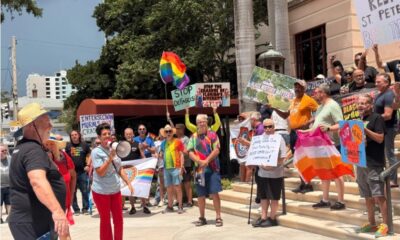Thrive
Local expert weighs in on inflation

Tampa Bay continues to pace the nation with its rate of price increases, a disheartening trend that began late last year.
In November 2021, the Tampa-St. Petersburg-Clearwater metro area’s inflation rate was 8%, compared to a national average of 6.8%. By February, the year-over-year price increases rose to 9.6%. According to the latest data released by the U.S. Bureau of Labor Statistics (BLS) in June, consumer prices in Tampa Bay soared by 11.3% in May compared to last year.
The national inflation rate for May, the highest level since December 1981, was 8.6%. So, why is the Tampa Bay region, which includes data from across Pinellas, Hillsborough, Pasco and Hernando Counties, experiencing the sharpest price spikes?
Dr. Richard Smith, associate professor of economics at the University of South Florida St. Petersburg campus, said it is hard to pinpoint one specific cause for the region’s inflation increases. However, he said the area’s precipitous growth and designation as a tourist destination creates more demand for essentials such as food, gas and housing.
“A general underlying pressure on prices is an increase in population,” said Smith. “Which has been particularly strong for Florida and Tampa Bay over the past couple of years – since the start of the pandemic.”
Smith, who received his doctoral degree from the University of Connecticut and previously served as a consultant for the Work Bank in Washington, D.C., said supply shocks caused by disruptions to the national and global supply chain have only pushed prices higher in the bay area. He said adding to the price pressure is a general resurgence of demand as Covid moves into an endemic stage or a constantly maintained baseline level.
“However, the pressure on Florida prices started at the beginning of the pandemic and have only been exacerbated by these other factors,” added Smith.
According to the BLS Consumer Price Index, fuel costs saw the sharpest increase in Tampa Bay – by a large margin. The price of gasoline in the region soared by 55% from May 2021 to this year, while the national average was 48.7%.
“Food at home” costs rose by 7.8% in Tampa Bay, with meats, poultry, fish and eggs leading the way with a 17% increase. Nationally, the price of groceries was higher at 11.9%, the steepest 12-month increase since April 1979.
Adding to the per-unit cost increase of eating at home is the rise of “shrinkflation,” the act of reducing a product’s size while maintaining its price point. Smith said the practice “makes a lot of sense” from a seller’s perspective.
“Make it look like you’re keeping a lid on price increases and taking some of the pain when in fact, you are just selling less,” said Smith. “Clever. My response is that if it has been going on – and perhaps longer than most of us realize – the secret is now out, which means it probably won’t be as easy to do going forward.”

Florida’s Chief Financial Officer recently sounded the alarm about “shrinkflation,” the practice of reducing a product’s size while maintaining its price point. Photo provided.
Also leading the way for the region’s inflation rate are energy costs. Electricity costs are up 18.5% compared to the national average of 12%, and those numbers are sure to rise as the BLS releases data for the summer months.
Smith said it is hard to say when Tampa Bay or the country will see inflation rates decrease, calling the current situation a “perfect storm” of several factors. He said geopolitical factors, particularly the Russian invasion of Ukraine, lead to uncertainty.
However, Smith added that China recently easing Covid restrictions and testing requirements could improve some supply chain issues.
“Which could at least ease some pressure on actual – and just as importantly, expected – inflation going forward,” he said.
Smith believes the Federal Reserve raising interest rates will help reduce inflation – the question is to what degree. The central bank raised rates by three-quarters of a percentage point in June, the sharpest increase since 1994. Chairman Jerome Powell suggested another similarly sized hike could come this month.
The Fed wants to reduce inflation to its 2% goal while keeping the labor market strong. For perspective, Tampa Bay’s inflation rate increased by 2.3% from March to May alone.
“I think the Fed realizes that some of these factors – such as oil prices, combined with oil industry hesitancy to commit further investment to oil refinement, and factors above – are beyond its control,” said Smith.
“What the Fed is trying to do, effectively, is grab one rein of a harness of a runaway horse that has other reins it can’t touch.”
There are signs of hope in other areas.
Although the BLS showed an increase of 12.1% for housing costs, and Florida Realtors reported a 28.4% increase in the median sales price for single-family homes in May to $413,108, total closed sales in Tampa Bay were down 7.5% from where they were the year before.
According to Redfin, luxury home sales in the region dropped by 20% from February to April, the steepest three-month decline since the onset of the pandemic in May 2020. Non-luxury home sales fell by 5.4% during the same period.
While Smith noted it was a difficult proposition, he said Tampa Bay residents should do whatever they can to avoid high prices and cut down on spending. He said that people should take some comfort in knowing that high inflation is affecting the entire world, with many industrialized countries experiencing higher price increases than the U.S.
“This means that all government leaders are very focused on the problem, taking all steps and utilizing all tools at their disposal to address the problem,” said Smith. “This is just my opinion, but I don’t think the sudden change in China’s Covid policy is a mere coincidence to the increasing inflation problem.
“We’ll see what happens.”







